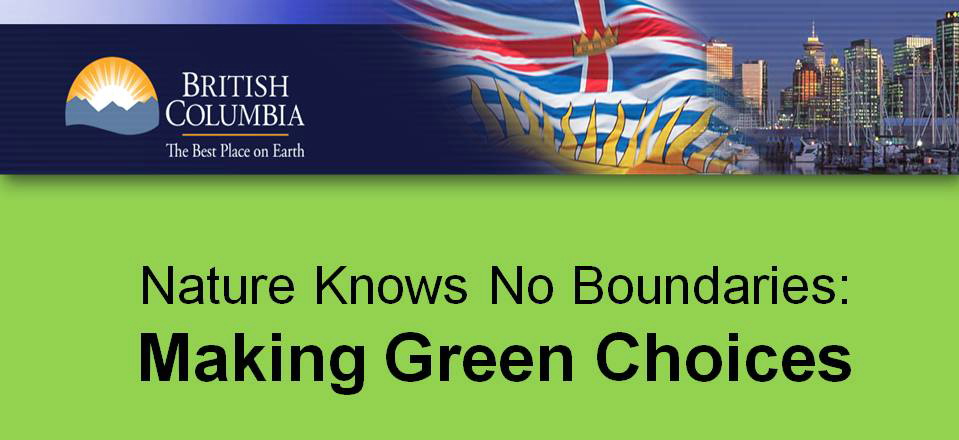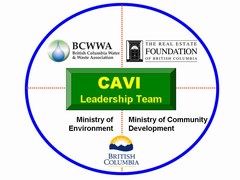Nature Knows No Boundaries – A Guide to Green Choices in British Columbia
Note to Reader:
Dr. Laura Tate was principal author of A Guide to Green Choices in British Columbia: Ideas & Practical Advice for Land Use Decisions in British Columbia Communities, released in 2008. The third seminar in the Comox Valley Learning Lunch Series was an early presentation in the rollout of the Guide by the provincial government. It was intended to be a living document. To this day, it is a relevant provincial resource.

Doing Business Differently in BC
To help local governments continue the extensive work they are already doing in fostering green communities, the Ministry of Community Development developed A Guide to Green Choices to provide practical advice and ideas in making land use decisions.
Released in September 2008, the expectation was that this Guide would work in tandem with many other provincial programs and projects then underway, including Living Water Smart, the BC Climate Action Plan and the Water Sustainability Action Plan for British Columbia. These initiatives shared a vision for encouraging land and water managers and users to do business differently.
Ideas & Practical Advice for Land Use Decisions
in British Columbia Communities
“The Ministry of Community Development appreciates input provided by the group of planning staff from across the province who informally reviewed a preliminary version of this document and provided helpful comments,” stated Laura Tate.
 “As British Columbians, we value a strong and growing economy together with our province’s unique array of ecosystems, natural beauty, and livable and diverse communities. Each of our respective communities is working to apply these values in its own setting.
“As British Columbians, we value a strong and growing economy together with our province’s unique array of ecosystems, natural beauty, and livable and diverse communities. Each of our respective communities is working to apply these values in its own setting.
“Our local governments have already made many positive choices in fostering green communities; and they want to do even more. As their partner in this goal, the Ministry of Community Development (MCD) developed A Guide to Green Choices to provide practical advice and ideas for green communities in making land use decisions. The guide is meant to assist communities of all types: large, small, rural, resort-based, urban, and suburban. It is designed to help maximize both creativity and adaptability to varied scales, specific contexts, and changing on-the-ground conditions.
“This is particularly important when working with local communities, where each have their own settings, histories, needs, and values—and of course their own unique visions for the future. For this reason, A Guide to Green Choices is intended to be a living document. It will be revised over time to address ongoing changes in community needs, and to respond to suggestions from local government.
“What will it look like when we arrive? This ‘green’ destination or vision will mean a healthier natural environment, healthier communities, and healthier citizens.”
To Learn More:
Download a copy of A Guide to Green Choices in British Columbia: Ideas & Practical Advice for Land Use Decisions in British Columbia Communities. To this day, it remains a relevant provincial resource.

Vancouver Island Learning Lunch Series
The Water Sustainability Action Plan comprises inter-connected program elements that give local governments and practitioners the tools and experience to better manage land and water resources.
One of the Action Plan program elements was the 2008 Vancouver Island Learning Lunch Seminar Series, a precedent-setting provincial pilot for building practitioner capacity. Two sets of three seminars each were held in the Summer and Fall in the Cowichan and Comox valleys, respectively.
Facilitating Alignment and Collaboration:
The City of Courtenay was the host municipality for the Comox Valley Learning Lunch Seminar Series. The final seminar in the series included a segment on A Guide to Green Choices. A presentation by Dr. Laura Tate, principal author of the Guide, set the scene for a Table Topic Group Exercise that addressed this topic:
- Tell us what you have learned from this series that will now help you do what you could not have done before.
Participants were asked to identify specific actions that would align local government efforts and facilitate regional collaboration.



Making Green Choices
In 2008, Dr. Laura Tate was with the Ministry of Community Development. Her role was Manager, Vancouver Island Growth Strategies. In this role, Laura collaborated with regional districts and provided support from the Ministry perspective. Laura opened her presentation by providing context for A Guide to Green Choices.
“We have a series of initiatives within the Ministry that are integrated with other broader provincial initiatives,” stated Laura Tate. “These are seeking to help us build green communities in our province..We all benefit from having attractive, liveable communities…with a healthy natural environment.”
Laura introduced and explained the four different pieces of the puzzle that her Ministry is tackling as part of its Green Communities Initiative. The Water Sustainability Action Plan is nested under this initiative.
She then described what is in A Guide to Green Choices. “We are providing local government with the information to make better decisions,” she said.
To Learn More:
Watch the YouTube video below. It is 10 minutes long. It is complemented by a PowerPoint presentation. Download a copy of Nature Knows No Boundaries – A Guide to Green Choices
To read a companion story about this provincial document, click on A Guide to Green Choices: Ideas & Practical Advice for Land Use Decisions in Britsh Columbia Communities — Ministry of Community Development document is expected to work in tandem with many other programs and projects.

About the Learning Lunch Seminar Series
The Learning Lunch Seminar Series promoted a consistent provincial approach to rainwater management and green infrastructure. The program was implemented through CAVI, which is the acronym for Convening for Action on Vancouver Island. In 2008, participating Vancouver Island local governments represented some 250,000 people.
- The Cowichan Valley series comprised a set of three sessions held during the June – July 2008 period. To learn more, visit https://waterbucket.ca/viw/category/convening-for-action-in-2008/2008-cowichan-valley-learning-lunch-seminar-series/ .
- The Comox Valley series comprised a set of three sessions held during the September – November 2008 period. To learn more, visit https://waterbucket.ca/viw/category/convening-for-action-in-2008/2008-comox-valley-learning-lunch-seminar-series/ .
The Learning Lunch Seminar Series was the first step in building a regional team approach so that there would be a common understanding and consistent messaging regarding on-the-ground expectations for rainwater management and green infrastructure. The Seminar Series was part of the implementation program for Beyond the Guidebook: The New Business As Usual, and was precedent-setting in its scope.
About CAVI
T he CAVI Partnership comprised the British Columbia Water & Waste Association, the Real Estate Foundation of British Columbia, the provincial Ministries of Environment and Community Development, and the Green Infrastructure Partnership. CAVI is co-funded by the Province and the Real Estate Foundation of British Columbia. The Water Sustainability Committee of the BCWWA was the managing partner and provided program delivery. In 2010, the committee morphed into the stand-alone and non-profit Partnership for Water Sustainability for BC.
he CAVI Partnership comprised the British Columbia Water & Waste Association, the Real Estate Foundation of British Columbia, the provincial Ministries of Environment and Community Development, and the Green Infrastructure Partnership. CAVI is co-funded by the Province and the Real Estate Foundation of British Columbia. The Water Sustainability Committee of the BCWWA was the managing partner and provided program delivery. In 2010, the committee morphed into the stand-alone and non-profit Partnership for Water Sustainability for BC.

